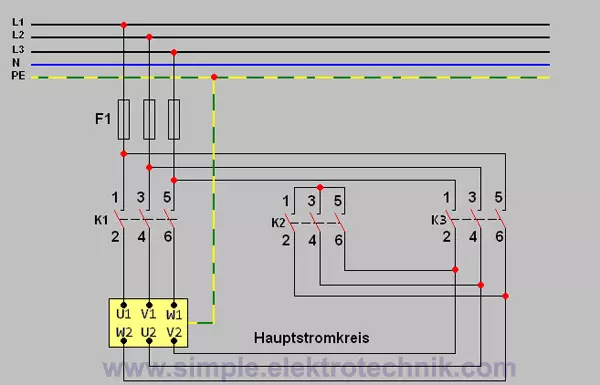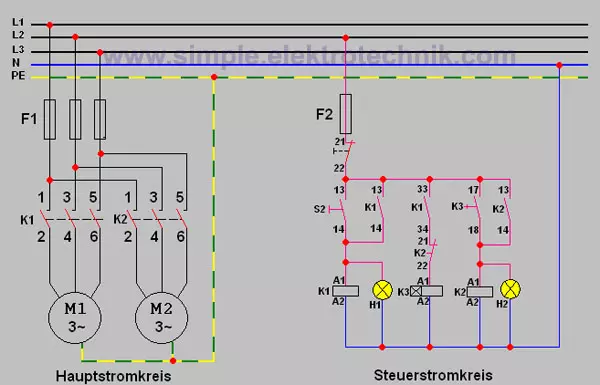Instructions for Wiring and Testing a Star-Delta Starting Circuit:
The star-delta starting circuit, also known as the YΔ circuit, is an important method for starting three-phase induction motors with reduced power consumption.
It prevents the triggering of overcurrent protection devices that can occur due to the high starting current in a direct start in the delta connection. In this guide, we will take a closer look at the construction, function, wiring, functional test, as well as the advantages and disadvantages of a star-delta starting circuit.
Construction and Function of a Star-Delta Starting Circuit:
The star-delta starting circuit is a method to start a three-phase motor step by step. It allows for a smooth and controlled motor start by initially connecting the motor in the star connection and then switching it to the more powerful delta connection.
The starting circuit consists of various components that are interconnected.

The main components include:
- Motor contactor. A motor contactor is an electrical switch that turns the motor on and off. In the star-delta starting circuit, a special motor contactor is used, which allows for the switch between star and delta connection.
- Star contactor. The star contactor is a contactor that establishes the connection of the motor windings in the star connection. In this configuration, the motor windings are connected to each other in a way that resembles a star.
- Delta contactor. The delta contactor is a contactor that establishes the connection of the motor windings in the delta connection. In this configuration, the motor windings are connected in a way that resembles a triangle.
- Motor protective circuit breaker. The motor protective circuit breaker monitors the motor for overload and short circuit conditions. It protects the motor from damage due to overcurrent and automatically shuts off the motor in case of a problem.
The sequence of a star-delta starting circuit is as follows:
- Start in the star connection. The motor contactor turns on the star contactor, which connects the motor windings in the star connection. In this configuration, less current flows through the windings, and the power consumption is only one-third compared to the delta connection. The motor starts with reduced power.
- Switch to the delta connection. After a specified time, which is sufficient to accelerate the motor to a certain speed, the motor contactor turns off the star contactor and turns on the delta contactor. This connects the motor windings in the more powerful delta connection. The motor reaches its full power and runs at normal speed.
The star-delta starting circuit offers the advantage of a smooth starting curve and reduces the starting current, which decreases motor wear and stresses on the network. It is mainly used in larger motors to avoid high starting currents.
The correct installation and wiring of the components are crucial for the proper functioning of the starting circuit. It is important to comply with the relevant safety regulations and, if necessary, consult a professional to ensure a safe and efficient star-delta starting circuit.
Wiring Diagram of the Main Circuit of a Star-Delta Starting Circuit

Wiring Diagram of the Control Circuit of a Star-Delta Starting Circuit

Wiring of a Star-Delta Starting Circuit:
To wire a star-delta starting circuit correctly, careful steps are required. Various components are used in the main circuit, including a main contactor (K1), a star contactor (K2), and a delta contactor (K3).
To activate the circuit, the button S2 is pressed. This activates the star contactor K2, closing the contacts 13 and 14. This, in turn, causes the main contactor K1 to turn on. To prevent the activation of the delta contactor K3 simultaneously, the normally open contacts 21 and 22 of K2 prevent its activation.
A thermal overload relay is used in the control circuit to protect the motor winding from overload or phase failure. The overload relay is installed after the main contactor in the motor circuit and set to a specific value. In case of a fault, the normally open contact of the overload relay interrupts the control circuit, thus protecting the motor winding.
To explain the individual steps in more detail:

- By pressing the button S2, the star contactor K2 is energized, closing the contacts 13 and 14. This turns on the main contactor K1.
- The normally open contacts 21 and 22 of K2 prevent the activation of the delta contactor K3 simultaneously.
- The normally closed contacts 13 and 14 of K1 keep the main contactor K1 and the star contactor K2 energized.
- Once the motor reaches its rated speed, the button S3 is pressed to switch the motor to the delta connection. This de-energizes the control circuit for the star contactor, and K2 turns off.
- The returning normally open contacts 21 and 22 of K2 energize the delta contactor K3.
- The normally open contacts 21 and 22 of K3 interlock with K2 to prevent simultaneous operation with the delta contactor K3.
If desired, corresponding indicator lights can be connected in parallel with the contactors K2 and K3 to indicate the operating states "Starting" (star connection) and "Running" (delta connection). The control can be switched off using the button S1.
Functional Test of a Star-Delta Starting Circuit:
The functional test of a star-delta starting circuit allows for an effective verification of correct functionality. Several steps are performed to ensure a smooth start-up.
A search engine optimized and easily readable presentation ensures optimal readability for the reader.

- To start the functional test procedure, the motor is first deactivated using the button S1.
Then, the button S2 is pressed to start the motor in the star connection.
In this configuration, the motor runs with reduced power, enabling a smooth start-up. - Once the motor is running stably in the star connection, the button S3 is pressed to switch the motor to the delta connection.
In this configuration, the motor runs at full power, ensuring maximum performance. - An essential aspect here is the use of time relays to ensure that the switching process does not occur too early.
This allows the motor sufficient time to stabilize in the star connection and enables a smooth transition to the delta connection.
The functional test of a star-delta starting circuit is an essential step to ensure correct functionality and optimal motor performance.

Advantages and Disadvantages of a Star-Delta Starting Circuit:
The star-delta starting circuit offers several advantages, such as reducing the starting current and avoiding overloads. It is cost-effective and easy to implement. However, it also has some disadvantages.
The motor runs momentarily unloaded during the switching process, which can lead to voltage fluctuations. Additionally, the circuit is not suitable for starting under load and requires manual switching.
Advantages of a Star-Delta Starting Circuit:
- Reduced starting current. The star-delta starting circuit allows for a step-by-step startup control of three-phase motors, resulting in a reduction of the starting current. This is particularly advantageous when using motors with high power ratings. By reducing the starting current, both the load on the power grid and the mechanical stress on the motor windings are reduced.
- Reduced inrush current. The star-delta starting circuit helps limit the inrush current that can occur when directly starting the motor. This is especially important in situations where a high inrush current can interfere with the operation of other electrical devices or overload the power supply. The step-by-step startup control reduces the inrush current, ensuring smoother motor operation.
- Cost-effectiveness. Compared to other starting methods, such as direct starting or soft starters, the star-delta starting circuit does not require additional expensive components. Since it is based on the connection of motor windings that already exist, it enables a cost-effective startup control of three-phase motors.
Disadvantages of a Star-Delta Starting Circuit:
- Torque reduction during startup. During the startup in the star-delta starting circuit, the motor's torque is reduced. This can be problematic in some applications, especially when high starting torque is required. For loads with high inertia or applications that require high starting torque, the star-delta starting circuit may not be the optimal choice.
- Limited application for certain motors. The star-delta starting circuit is not suitable for all types of motors. It is best suited for motors with Y or star windings, while it is not effective for motors with other winding types such as delta windings. Therefore, before implementing a star-delta starting circuit, it must be ensured that the motor is compatible with this starting method.
- Limited application for variable frequency drives. The star-delta starting circuit is less suitable for motors used in variable frequency drives. Since variable frequency drives require precise torque control, the star-delta starting circuit may not provide the required flexibility. In such cases, alternative starting methods such as vector control or soft starters are preferred.
Overall, the star-delta starting circuit is a proven method for starting three-phase motors with reduced power consumption. Proper wiring and functional testing ensure efficient and reliable motor operation.
Elektrosicherheit: Richtlinien und Vorsichtsmaßnahmen für einfache elektrotechnische Arbeiten
Die Sicherheit hat oberste Priorität.

- Alle hier bereitgestellten Anleitungen und Informationen dienen rein informativen Zwecken und sollen ausschließlich zur Informationsbeschaffung und Weiterbildung verwendet werden. Sie sollten nicht als Ersatz für professionelle Beratung angesehen werden. Bei Zweifeln empfiehlt es sich, einen qualifizierten Elektriker hinzuzuziehen, um fachkundige Unterstützung zu erhalten.
- Es ist wichtig, die örtlichen Vorschriften und Bestimmungen bei elektrischen Arbeiten zu beachten. Arbeiten mit Strom sollten nur von qualifizierten Fachleuten durchgeführt werden, da sie lebensgefährlich sein können.
- Fehler in Anleitungen und Schaltbildern sind möglich. Der Anbieter übernimmt keine Gewähr oder Haftung für Schäden oder Verletzungen, die aus der Umsetzung der bereitgestellten Informationen resultieren könnten. Es liegt in Ihrer Verantwortung, die Richtigkeit der Informationen zu überprüfen und die erforderlichen Sicherheitsvorkehrungen zu treffen.
- Die Verwendung geeigneter persönlicher Schutzausrüstung (PSA) ist entscheidend, um die Sicherheit bei elektrotechnischen Arbeiten zu gewährleisten. PSA schützt vor Stromschlägen, Augenverletzungen, thermischen und mechanischen Gefahren. Es ist jedoch wichtig zu beachten, dass PSA allein nicht ausreicht und durch Fachwissen, Fähigkeiten und die Einhaltung von Sicherheitsvorschriften ergänzt werden muss.
- Arbeiten an Teilen, die unter Spannung stehen, sind strengstens untersagt. Vor Beginn der Arbeiten müssen geeignete Sicherheitsvorkehrungen getroffen werden, einschließlich des Freischaltens der Anlage.
- Bei Schäden durch mangelhafte Elektroinstallation haftet der Errichter der Anlage gemäß den geltenden gesetzlichen Bestimmungen.
- Diese Zusammenfassung von Richtlinien und Vorsichtsmaßnahmen ist nicht umfassend. Bei Unsicherheiten ist es ratsam, einen qualifizierten Elektriker zu konsultieren oder sich an örtliche Vorschriften und Bestimmungen zu halten, um maximale Sicherheit zu gewährleisten.
- Die ordnungsgemäße Installation und Wartung von elektrischen Anlagen und Geräten ist von großer Bedeutung, um mögliche Gefahren zu minimieren und ein sicheres Umfeld zu schaffen.
Hier sind einige wichtige Begriffe aus der Elektrotechnik mit kurzen Erläuterungen:
Strom
Der Strom ist die elektrische Ladung, die pro Zeiteinheit durch einen elektrischen Leiter fließt. Er wird in Ampere (A) gemessen.
Spannung
Die Spannung ist die elektrische Potentialdifferenz zwischen zwei Punkten in einem elektrischen Stromkreis. Sie wird in Volt (V) gemessen und ist verantwortlich für den Stromfluss.
Widerstand
Der Widerstand ist ein Maß für die Fähigkeit eines Bauteils oder Leiters, den Stromfluss zu behindern. Er wird in Ohm (Ω) gemessen und folgt dem Ohmschen Gesetz.
Leistung
Die Leistung ist die Menge an Arbeit pro Zeiteinheit, die in einem elektrischen System verrichtet oder übertragen wird. Sie wird in Watt (W) gemessen und berechnet sich als das Produkt aus Strom und Spannung.
Ohmsches Gesetz
Das Ohmsche Gesetz besagt, dass der Strom durch einen elektrischen Leiter proportional zur angelegten Spannung und umgekehrt proportional zum Widerstand ist: I = U/R.
Kirchhoffsche Gesetze
Die Kirchhoffschen Gesetze sind grundlegende Prinzipien in der elektrischen Schaltungstechnik. Das erste Gesetz besagt, dass in einem Knotenpunkt eines Stromkreises die Summe der eingehenden Ströme gleich der Summe der ausgehenden Ströme ist. Das zweite Gesetz besagt, dass in einer geschlossenen Schleife die Summe der Spannungsabfälle gleich der Summe der Spannungsquellen ist.
Gleichstrom (DC)
Gleichstrom ist ein elektrischer Strom, bei dem die Richtung des Stromflusses konstant ist.
Wechselstrom (AC)
Wechselstrom ist ein elektrischer Strom, bei dem die Richtung des Stromflusses periodisch wechselt. In den meisten Haushalten und in der öffentlichen Stromversorgung wird Wechselstrom verwendet.
Frequenz
Die Frequenz ist die Anzahl der Perioden (Schwingungen) pro Zeiteinheit in einem periodischen Signal. In der Elektrotechnik wird sie in Hertz (Hz) gemessen.
Phasenverschiebung
Die Phasenverschiebung ist der zeitliche Unterschied zwischen zwei periodischen Signalen, die in der Regel sinusförmig sind. Sie wird in Grad oder Rad gemessen und gibt an, wie weit das eine Signal in Bezug auf das andere verschoben ist.
Schaltbild
Ein Schaltbild ist eine vereinfachte grafische Darstellung eines elektrischen Schaltkreises. Es zeigt die Komponenten und deren Verbindungen.
Kondensator
Ein Kondensator ist ein elektronisches Bauteil, das elektrische Ladung speichern kann. Er besteht aus zwei leitenden Platten, die durch ein Dielektrikum (Isolator) getrennt sind.
Korrespondierende Leiter
Korrespondierende Leiter sind zwei Leiter, die durch elektromagnetische Induktion miteinander verbunden sind, z.B. eine Primär- und eine Sekundärspule in einem Transformator.
Spule
Eine Spule ist ein Bauteil, das aus einer gewickelten Drahtwicklung besteht. Sie erzeugt ein magnetisches Feld, wenn Strom durch sie fließt, und kann in der Induktivität messbare Effekte haben.
Induktivität
Die Induktivität ist die Fähigkeit einer Spule, eine Spannung zu erzeugen, wenn sich der Strom durch sie ändert. Sie wird in Henry (H) gemessen und beeinflusst den Stromfluss in Wechselstromkreisen.
Kapazität
Die Kapazität ist die Fähigkeit eines Kondensators, Ladung zu speichern. Sie wird in Farad (F) gemessen und beeinflusst den Stromfluss in Wechselstromkreisen.
Transistor
Ein Transistor ist ein elektronisches Bauteil, das als Verstärker oder Schalter in Schaltungen verwendet wird. Es besteht aus Halbleitermaterial und kann den Stromfluss steuern.
Halbleiter
Ein Halbleiter ist ein Material, das eine elektrische Leitfähigkeit zwischen einem Isolator und einem Leiter aufweist. Halbleitermaterialien wie Silizium oder Germanium werden in der Elektronik verwendet.
Dioden
Eine Diode ist ein elektronisches Bauteil, das den Stromfluss nur in eine Richtung zulässt. Sie besteht aus einem Halbleitermaterial und wird oft als Gleichrichter eingesetzt.
Relais
Ein Relais ist ein elektromechanisches Schaltgerät, das einen elektrischen Stromkreis steuern kann. Es besteht aus einer Spule und einem Schalter, der durch die Spule betätigt wird.
Schalter
Ein Schalter ist ein elektronisches Bauteil oder Gerät, das den Stromkreis unterbrechen oder schließen kann, um den Stromfluss zu steuern.
Netzwerk
Ein Netzwerk ist eine Verbindung von elektrischen Komponenten, Bauteilen oder Schaltungen. Es kann verschiedene Topologien wie Serienschaltung oder Parallelschaltung aufweisen.
Transformator
Ein Transformator ist ein elektrisches Gerät, das die Spannung und den Strom in einem Wechselstromkreis ändern kann. Er besteht aus zwei oder mehr Spulen und nutzt die elektromagnetische Induktion.
Elektromagnet
Ein Elektromagnet ist ein Magnet, der durch den Stromfluss in einer Spule erzeugt wird. Er besteht aus einem Kernmaterial und einer Spule und wird in vielen Anwendungen wie Elektromotoren eingesetzt.
Impedanz
Die Impedanz ist der Gesamtwiderstand für den Stromfluss in einem Wechselstromkreis. Sie umfasst den Widerstand und die reaktive Komponente (induktive oder kapazitive).
Kurzschluss
Ein Kurzschluss tritt auf, wenn ein Leiter einen sehr geringen Widerstand aufweist und den Strom ungehindert fließen lässt. Es kann zu einer Überlastung führen und gefährlich sein.
Stromkreis
Ein Stromkreis ist ein geschlossener Pfad, durch den der elektrische Strom fließt. Er besteht aus einer Stromquelle, Verbrauchern und Verbindungen.
Serienschaltung
Eine Serienschaltung ist eine Verbindung von elektrischen Komponenten, bei der der Strom durch jeden Verbraucher denselben Pfad nimmt. Die Gesamtspannung teilt sich auf die Verbraucher auf.
Parallelschaltung
Eine Parallelschaltung ist eine Verbindung von elektrischen Komponenten, bei der der Strom sich aufteilt und durch jeden Verbraucher einen separaten Pfad nimmt. Die Spannung bleibt für jeden Verbraucher gleich.
Sicherung
Eine Sicherung ist ein Schutzbauteil, das in einem Stromkreis eingefügt wird, um vor Überstrom zu schützen. Bei zu hohem Stromfluss schmilzt die Sicherung und unterbricht den Stromkreis.
Überstromschutz
Der Überstromschutz ist ein Mechanismus oder eine Vorrichtung, die den Stromkreis vor Schäden durch übermäßigen Stromfluss schützt. Dies kann durch Sicherungen, Schutzschalter oder Relais erfolgen.
Erdung
Die Erdung ist eine Verbindung eines elektrischen Systems oder Geräts mit der Erde. Sie dient dazu, elektrische Ströme sicher abzuleiten und das Risiko von Stromschlägen zu verringern.
Frequenzumrichter
Ein Frequenzumrichter ist ein elektronisches Gerät, das die Frequenz eines Wechselstroms ändern kann. Er wird häufig in der Antriebstechnik eingesetzt, um die Geschwindigkeit von Elektromotoren zu regeln.
Elektromagnetische Verträglichkeit (EMV)
Die elektromagnetische Verträglichkeit befasst sich mit der Fähigkeit von elektrischen Geräten und Systemen, elektromagnetische Störungen zu verhindern und nicht von ihnen beeinflusst zu werden.
Verlustleistung
Die Verlustleistung ist die elektrische Leistung, die in einem Bauteil oder System in Form von Wärme verloren geht. Sie tritt aufgrund von Widerstand, Induktivität und Kapazität auf.
Kurzschlussstrom
Der Kurzschlussstrom ist der Strom, der durch einen Stromkreis fließt, wenn ein Kurzschluss auftritt. Er kann extrem hoch sein und muss bei der Dimensionierung von Schutzvorrichtungen berücksichtigt werden.
Leistungsfaktor
Der Leistungsfaktor ist das Verhältnis zwischen Wirkleistung (tatsächlich genutzte Leistung) und Scheinleistung (Produkt aus Strom und Spannung) in einem Wechselstromkreis. Er gibt an, wie effizient die elektrische Leistung genutzt wird.
Isolationswiderstand
Der Isolationswiderstand ist der elektrische Widerstand zwischen zwei Leitern, die durch eine Isolierung voneinander getrennt sind. Er gibt Auskunft über die Qualität der Isolierung und wird oft bei Sicherheitsprüfungen gemessen.